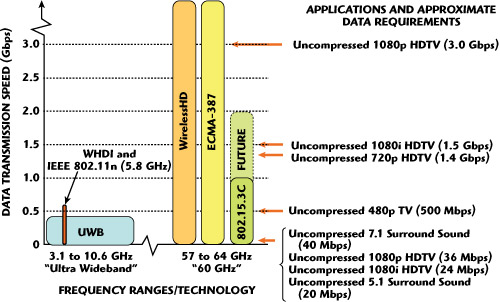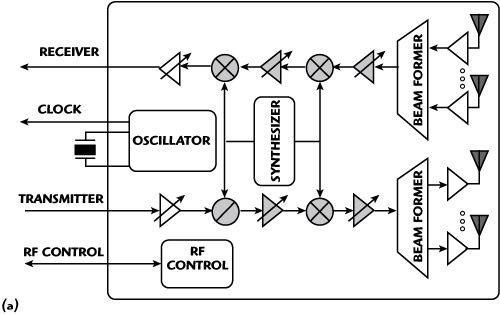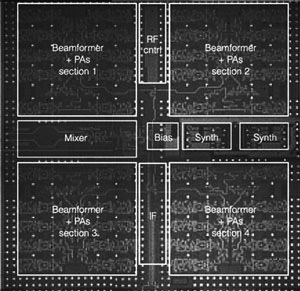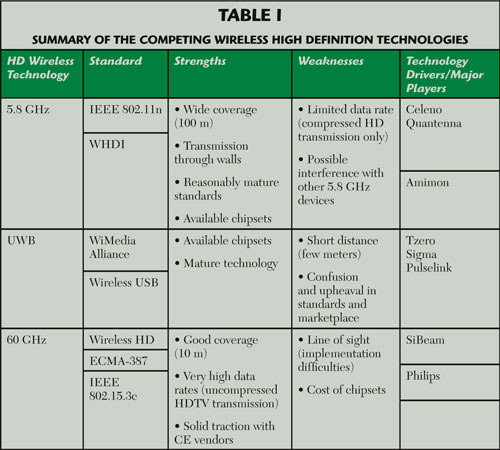High Definition Television (HDTV) is an already mature consumer electronics (CE) field. However, it is a field that is still cluttered by a rats nest of interconnecting wires.
Home theatre systems are often built around a sleek, flat-panel audio-visual (AV) display hanging on a wall, often connected to a variety of high definition (HD) sources; for example, cable or satellite set-top boxes, blue-ray disc players, gaming consoles and/or broadband Internet connections. An example setup is shown in Figure 1. Connecting this display (or often multiple displays) to the many HD content sources requires a suite of specialist cables and switches, most of which are costly, bulky and unsightly. Although such cables are effective at carrying the high data rates required, many users would prefer a more elegant wireless solution, if available, especially if it eliminated the mass of wires, removed the interconnection headaches, and provided seamless networking capabilities between multiple sources and viewing devices.

Figure 1 Example of possible home theater setup.
HDMI™ (High Definition Multimedia Interface) has emerged in recent years as the enabling CE HD digital interface. HDMI permits data transfer at rates of 3 Gbps and higher; equivalent to 1080p video, the highest specification HDTV and AV standard commonly available today (note: The “1080” stands for 1,080 horizontal scan lines, which with the common widescreen aspect ratio of 16:9 implies a horizontal resolution of 1920 pixels, and thus a frame resolution of 1,920 × 1,080 or 2 million pixels. The “p” stands for progressive scan, meaning all the horizontal lines are drawn in sequence. Another standard mentioned in this paper is 1080i, which employs the same number of pixels, but interlaced, meaning only each second line is refreshed each scan. This allows the system data rate to be halved, but at the expense of some picture quality degradation). More than 500 million devices are forecast to be shipped with HDMI interfaces by 2010.1
Several wireless technologies in the 5 to 60 GHz frequency bands are under development to provide HDMI interconnectivity in living-room environments for linking together HDTV and other multi-media sources without wires. Major CE companies are starting to rollout models, with prototypes being displayed at recent CE trade shows. This paper reviews these technologies, providing an insight into the main contenders, standards, industry groups and commercial players that make up the wireless high definition landscape.
The Wireless HD Technology Landscape

Figure 2 Short distance wireless HD technologies and data rate requirements for various HD multimedia applications.
A summary of the wireless technologies vying for acceptance as short distance high data rate HD distribution technologies is shown in Figure 2, along with the data rate requirements for various multimedia AV applications, from surround sound to the highest quality uncompressed HDTV.
Lower Microwave Bands for Compressed Wireless HD Connectivity
Within the lower microwave bands, there are three technologies able to support high definition multimedia transport. Two similar technologies, Wireless Home Digital Interface™ and IEEE 802.11n, operate within the 5.8 GHz band that is unlicensed in the US. Here channel sizes are limited to 20 MHz, restricting the amount of data that can be transferred. This means that only compressed, or some form of limited capability, HD can be transmitted. However, with proper design, such compression can have minimal perceived effect on viewed picture quality. The other, Ultra-wideband (UWB), operates with much wider channels, but has power limitations that restrict its distance capabilities. Each of these three technologies is explored further below.
IEEE 802.11n
IEEE 802.11n is one of the more recent iterations of the IEEE 802.11 wireless Local Area Network (LAN) standard, more commonly known as WiFi. IEEE 802.11n extends the previous theoretical maximum limit beyond 54 Mbps by use of multiple in, multiple out (MIMO) antenna technology, complex beamforming and channel aggregation to achieve theoretical data rates up to 600 Mbps. Although not yet formally released as a standard, “Draft N” products compliant with the current draft standard are widely available. Intel, for example, produces the Ultimate N WiFi chipset that is 802.11a/b/g/Draft-N compliant and offers data rates up to a maximum of 450 Mbps.2 The 802.11n standard is due for formal ratification in January 2010.
The ubiquitous availability and low cost of WiFi chipsets makes the use of this standard a rational choice for consumer-oriented multimedia applications. As such, vendors such as Celeno Wireless Communications and Quantenna Communications are employing 802.11n-based solutions for wireless HDMI-like applications. Quantenna’s solution employs 4 × 4 MIMO, transmitter beamforming and dual-band operation (the unlicensed 2.4 GHz as well as the 5.8 GHz) to yield very high data rates in a small chip footprint.
One big advantage of 802.11n is that range is typically beyond 100 feet (30 m), with signals easily able to penetrate walls. Thus, this 5.8 GHz solution has potential for a “whole home” distribution solution rather than for a single room. However, with the explosion of other WiFi-enabled devices, the risk of interference grows over time.
Wireless Home Digital Interface (WHDI™)
WHDI is physically very similar to IEEE 802.11n, operating in the same 5.8 GHz unlicensed band and employing MIMO antenna technology to achieve similar data throughputs. However, WHDI differs from IEEE 802.11n in that it was specifically developed for video, audio and AV control, making it a more robust technology for HDTV delivery.
WHDI was developed by Amimon in Israel, with Motorola as an early backer and investor. In 2008, a WHDI special interest group was formed, which now includes Hitachi, Samsung, Sharp, Sony and LG Electronics as members. Amimon sold over 100,000 WHDI chipsets in 2008. Pricing for production quantities of Amimon’s WHDI transmitter chipset is $20 and $25 for the receiver. The first WHDI products are expected to be available around the end of 2009.
Although WHDI claims uncompressed video data rates up to 1.5 Gbps in the 20 MHz channels available at 5.8 GHz (and 3.0 Gbps in paired 40 MHz channels), closer investigation of the technology and marketing fine print shows that these are actually “equivalent” data rates and data compression is clearly employed to achieve them. Amimon uses a technique called Joint Source Channel Coding (JSCC) to provide “lossless compression”, whereby the 1.5 Gbps 1080i HD video rate is reduced to between 250 and 800 Mbps.3 JSCC works by breaking down the uncompressed HD video stream into elements of importance, each of which is then mapped onto the wireless channel in a way that allocates priority and robustness to the most important data elements, transmitting them with the highest amounts of error correction. Less significant data is allocated less preference and lower error correction protection. When transmitted, so long as the higher priority data bits are not degraded, the user can tolerate the degradation of the less important data bits, and visual and audio quality close to the original uncompressed signal is maintained.
Neither Amimon nor WHDI publishes the actual data throughout of their technology. However, given WHDI’s physical similarity to IEEE 802.11n, comparable data rates of around 400 to 600 Mbps are expected.
Ultra-wideband
UWB is a technology that employs very low radio energy signals, spread over a wide frequency range, for short-range high-bandwidth communications. The FCC has approved the frequency band of 3.1 to 10.6 GHz for such transmissions. Global differences exist in how the bands are regulated around the world.
The UWB landscape is rather confusing with a number of industry organizations and special interest groups with much overlap and duplication. One leading group was the WiMedia Alliance, who was working to promote the adoption, regulation, standardization and multi-vendor interoperability of their Orthogonal Frequency Division Multiplexing (OFDM) UWB technology that delivered data rates of up to 480 Mbps at 10 ft (3 m) distances and 110 Mbps at 30 ft (10 m) distances. In March 2009, the WiMedia Alliance announced it was ceasing, and would be transferring all its current and future UWB specifications to the Bluetooth Special Interest Group, the USB Implementers Forum and the Wireless USB Promoter Group. This latter group champions its own Wireless USB standard, plus manages the “Certified Wireless USB™” distinction. Although different, Wireless USB is based upon the WiMedia Alliance’s common UWB radio platform. An upcoming 1.1 Wireless USB specification will increase speeds to 1 Gbps.
In addition to these groups, many individual companies are championing wireless high definition connectivity via proprietary implementations of the WiMedia UWB framework. Given the short distance and data rate limitations of UWB, few UWB proponents are targeting HD multimedia applications. Three that are doing so successfully are TZero Technologies with its ZeroWire™ chipset and HDMI reference design kit, Sigma Designs with its Wireless HDAV™ products and Pulse~LINK with its CWave® UWB chipset.
MM-Wave Bands for Uncompressed Wireless HD Connectivity
The mm-wave frequency bands offer a big advantage for high data rate wireless transmission spectrum.4 Of interest here is the 7 GHz of bandwidth available from 57 to 64 GHz for unlicensed use in the US. Closely related frequency bands are available in Canada, Japan, Australia and under consideration in Europe. With 7 GHz of bandwidth available, multi-gigabit data rates can easily be achieved with conventional radio architectures without the system complexities needed to compress high data rates into the narrow channels available at lower frequencies (such as the much smaller 20 MHz channels available at 5.8 GHz). High atmospheric absorption of oxygen molecules at 60 GHz does limit propagation distances, making 60 GHz systems better suited for in-room, short-range use, rather than across a whole house. However, these distance limitations do help to control intersystem interference and abate “off site” reception concern of multimedia copyright owners.
Within the 60 GHz mm-wave band, there are three technologies being developed to support uncompressed HD multimedia transport. Being able to support uncompressed HD is especially advantageous in providing not only the ultimate in picture quality, but also for minimizing latency; a key requirement for gaming applications. Each of these three 60 GHz mm-wave technologies is explored further here.
Wireless HD™
WirelessHD is a standard specifically designed for wireless high definition multimedia connectivity. The WirelessHD consortium was formed in 2005 to promote the technology developed by SiBEAM. The group now includes Broadcom, Intel, LG, Panasonic, NEC, Samsung, Sony and Toshiba as members. The goals of the group were to develop a standard that met the following minimum set of requirements:
- Stream uncompressed high-definition video, in addition to audio and data
- High reliability
- Low cost
- Low power solutions for portable devices
- In-room connectivity (equating to a range of around 10 m)
The first WirelessHD specification was finalized in early 2008. In its first generation implementation, data rates as high as 4 Gbps were achieved. The core technology promotes theoretical data rates as high as 25 Gbps, permitting it to scale to significantly higher resolutions, color depth and range than available today. LG, Panasonic and Toshiba have all announced that they plan to ship commercial WirelessHD products in 2009.
WirelessHD employs beamforming technology to steer line-of-sight beams around a room. Adaptive beam steering and phased-array antennas move the high data rate content stream around the room, bouncing off walls, ceilings and floors without interruption. If a direct path becomes obstructed, the system quickly adapts and finds an alternative path for continuous streaming without any breaks (for example, around people walking across a room and blocking the main signal between HD transmitters and receivers).


Figure 3 Radio architecture (a) and die photo (b) of siBEAM's integrated 60 GHz chip.6
Historically, millimeter-wave electronic components have only been feasible in relatively expensive and bulky semiconductors such as Gallium Arsenide (GaAs) and Indium Phosphide (InP). Using techniques developed by the University of Berkeley, SiBEAM has developed 130 nm CMOS chips that operate to 60 GHz.5 These low cost silicon chips form the heart of its OmniLink 60 WirelessHD product. A block diagram and photo of the chips are shown in Figure 3. Having a silicon solution rather than GaAs or InP helps towards the all-important goal of reducing system cost to a price point competitive with HDMI cables. Also, system designs are being simplified; for example, initial designs that employed 36 patch antennas are being redesigned to operate with half that number of devices.
ECMA-387
Similar to WirelessHD, ECMA-387 is a 60 GHz standard that provides support for Gbps streaming video applications. However, unlike Wireless HD, ECMA-387 was developed to support more than uncompressed HD multimedia connections. The standard has provisions for fast file download support, wireless docking and even short distance point-to-multipoint “sync and go” for handheld devices. Developed by Ecma International with support from Phillips, Intel, Samsung, Panasonic and others, EMCA-387 has the potential to become the European standard for short-range wireless ultra-high data rate networking. Ecma has already submitted the standard, published in December 2008, for fast-track consideration as an ISO/IEC standard.
The ECMA-387 standard supports data rates to 6.4 Gbps, which with channel bonding of up to four channels can extend data rates to beyond 25 Gbps. The Georgia Electronic Design Center have just recently demonstrated an ECMA-compliant chip supporting multi-gigabit per second file transfers and 1080i uncompressed HD video streaming. The single-chip 60 GHz CMOS radio consumes less than 100 mW and incorporates an embedded antenna array, a 60 GHz front-end and multi-gigabit baseband signal processing into a standard QFN package.7
IEEE 802.15.3c
The IEEE 802.15.3 Task Group 3c was formed in March 2005 to develop a 60 GHz physical layer (PHY) for the existing Wireless Personal Area Network (PAN) Standard 802.15.3-2003. Although still under development and slated for publication in late 2009, this IEEE standard is designed to ensure compliance and coexistence with all other microwave systems in the 802.15 family of wireless PANs. In addition, the standard will support high data rates to at least 1 Gbps, with an option to support rates in excess of 2 Gbps in future options. Support of the uncompressed HDTV multimedia standards is a clear objective of the group.
Conclusion
There is a clear consumer desire to remove the mess of HDMI cables and interconnection headaches associated with modern HD multimedia systems. Several different wireless technologies are available that offer the promise of such cable-free high definition connectivity, providing users with seamless networking capabilities and visually-pleasing HD home theatre setups. However, there is a complex mix of standards, innovation, technologies and costs that companies have to balance before any clear winner gains dominance in the home. The current technical competitive situation is detailed in Table 1.

Table 1 Summary of the competing wireless high definition technologies.
Three classes of system are in various stages of advancement. Systems based on the IEEE 802.11n standard (including the closely related WHDI) offer the advantages of household-wide coverage and the ability to support the higher quality HDTV formats. However, due to the limited channel sizes available in the 5.8 GHz operational band, some form of data compression is required, with a resulting latency penalty and some level of picture degradation. Nevertheless, the use of the relatively low and widely available 5.8 GHz frequency band opens up the possibilities of relatively low cost chipsets that are becoming widely available through the association with the standard WiFi protocol.
UWB is another technology that offers short distance, high capacity connectivity. However, the restricted power levels limit high capacity transmission distances to just a few feet, making the technology of limited use for living room applications. In addition, the unclear standard’s roadmap and varied worldwide regulatory climate will hamper UWB’s adoption as a widely used HDTV transmission protocol.
One class of technology offering great promise is those operating within the millimeter-wave band around 60 GHz. Here, high bandwidths, favorable propagation characteristics and almost global regulatory recognition make such systems ideal for the connection of HD devices without the need for latency-inducing compression algorithms. WirelessHD has the head start amongst the applicable 60 GHz short-range standards, with several systems in demonstration and commercial availability announced for this year. However, the ECMA-387 standard is close behind, which like the emerging IEEE 802.15.3c standard, has the potential to move beyond wireless high definition and multi-media support to a wide range of high data rate applications and global backing via the ISO and IEEE standards organizations.
So which technology will win the battle for the living room? Amimon’s WHDI and SiBEAM’s WirelessHD are leading the charge. Both have reasonably mature standards and various technology strengths. WHDI can provide wide-area coverage with low cost chipsets, but limits future scalability by being constrained to data rate liming channels. WirelessHD can support vastly larger data rates, but is shorter distance, more complex and potentially more costly to implement. At the end of the day, the dominance by CE vendors to “pull” one technology in front of the other will win in the marketplace. Both WHDI and WirelessHD boast strong traction with big-name CE vendors.
In the not too distant future, we will likely see microwave or millimeter-wave systems in our living rooms, seamlessly connecting our HD devices and wirelessly streaming digital content, removing the need for a mass of interconnecting cables and switches. Now if only we could develop a technology to remove those pesky power cords.
References
1. A. Malhotra, “The Gigabit Smartphone,” Wireless Week, Jan 8, 2009. Available online at http://www.wirelessweek.com/Gigabit-Speed-Smartphone.aspx.
2. Intel® Ultimate N WiFi Link 5300 Product Brief. Available online at http://download.intel.com/network/connectivity/products/wireless/319982.pdf.
3. “Enabling Wireless Uncompressed HDTV Connectivity with a Unique Video-modem Approach: A Technical Overview,” Amimon white paper, undated.
4. J.A. Wells, “Faster Than Fiber: The Future of Multi-Gb/s Wireless,” IEEE Microwave Magazine, Vol. 10, No. 3, May 2009, pp. 104-112.
5. “SiBEAM Inc. Delivers High-Performance WirelessHD™ Chipsets into Production and Touts Audio/Video and Data Capabilities,” SiBEAM press release, January 6, 2009.
6. J.M. Gilbert, C.H. Doan, S. Emami and C.B. Shung, “A 4-Gbps Uncompressed Wireless HD A/V Transceiver Chipset,” IEEE Micro, Vol. 28, Issue 2, March-April 2008, pp. 56-64.
7. J. Lasker, “60 GHz CMOS Low Power Single Chip Radio: The Intersection of Gaming and Connectivity,” IEEE Radio and Wireless Symposium Digest, January 2009, pp. 654-7.
